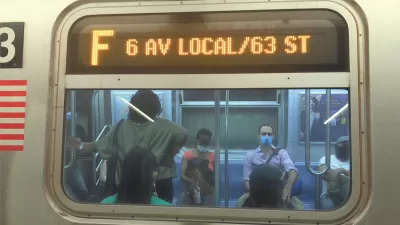The U.S. House of Representatives approved the Health and Economic Recovery Omnibus Emergency Solutions Act earlier this month. Transit advocates say the bill reinforces the car-centric status quo.

"The latest COVID-19 relief bill perpetuates some of the worst aspects of American transportation policy — and barely acknowledged how our transportation realities have shifted in the wake of the pandemic," according to Kea Wilson's assessment of the HEROES Act.
The Health and Economic Recovery Omnibus Emergency Solutions Act has been approved by Democrats in the House of Representatives, but Senate Republicans have been less than supportive, so the bill is likely to change substantially if it is approved.
Among the spending included in the proposed $3 trillion bill are $15 billion for the Federal Highway Administration to distribute to transportation departments across the country and $16 billion for public transit. "Advocates quickly questioned both numbers — the former because it was too large, and the latter because it was too small," according to Wilson.
As explained by Wilson, the American Association of State Highway Transportation Officials has been lobbying for funding to deal with anticipated shortages of transportation revenues as people stay home and drive less at unprecedented levels. Planetizen has covered news about expected gas tax revenue declines in Missouri and California.
On the transit side, the American Public Transportation Association earlier this month requested $23.8 billion in emergency funds to support public transit, so the HEROES Act falls far short.

Pennsylvania Mall Conversion Bill Passes House
If passed, the bill would promote the adaptive reuse of defunct commercial buildings.

Planning for Accessibility: Proximity is More Important than Mobility
Accessibility-based planning minimizes the distance that people must travel to reach desired services and activities. Measured this way, increased density can provide more total benefits than increased speeds.

World's Largest Wildlife Overpass In the Works in Los Angeles County
Caltrans will soon close half of the 101 Freeway in order to continue construction of the Wallis Annenberg Wildlife Crossing near Agoura Hills in Los Angeles County.

Colorado Bans No-Fault Evictions
In most cases, landlords must provide a just cause for evicting tenants.

Alaska Village Becomes Test Case for Climate Change Relocation
The Yup’ik village of Newtok is the first Alaska community to begin a full-scale relocation necessitated by the impacts of climate change. Another 31 Alaska communities remain vulnerable.

Amtrak Takes Lead on Texas Central Rail
The high-speed rail project isn’t a done deal, but if it moves forward, trains could begin operating in 2030.
City of Costa Mesa
Licking County
Barrett Planning Group LLC
HUD's Office of Policy Development and Research
Mpact Transit + Community
HUD's Office of Policy Development and Research
Tufts University, Department of Urban and Environmental Policy & Planning
City of Universal City TX
ULI Northwest Arkansas
Urban Design for Planners 1: Software Tools
This six-course series explores essential urban design concepts using open source software and equips planners with the tools they need to participate fully in the urban design process.
Planning for Universal Design
Learn the tools for implementing Universal Design in planning regulations.


























